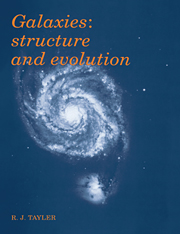Book contents
- Frontmatter
- Contents
- Preface
- Symbols
- Numerical values
- 1 Introduction
- 2 Observations of the Galaxy
- 3 Properties of external galaxies
- 4 Stellar dynamics
- 5 Masses of galaxies
- 6 The interstellar medium in our Galaxy
- 7 The chemical evolution of galaxies
- 8 Galaxies and the Universe
- 9 Concluding remarks
- Appendix 1 Some factors influencing stellar spectra
- Appendix 2 The Virial Theorem
- Appendix 3 Gravitational fields due to spheres and ellipsoids
- Suggestions for further reading
- Index
8 - Galaxies and the Universe
Published online by Cambridge University Press: 05 June 2012
- Frontmatter
- Contents
- Preface
- Symbols
- Numerical values
- 1 Introduction
- 2 Observations of the Galaxy
- 3 Properties of external galaxies
- 4 Stellar dynamics
- 5 Masses of galaxies
- 6 The interstellar medium in our Galaxy
- 7 The chemical evolution of galaxies
- 8 Galaxies and the Universe
- 9 Concluding remarks
- Appendix 1 Some factors influencing stellar spectra
- Appendix 2 The Virial Theorem
- Appendix 3 Gravitational fields due to spheres and ellipsoids
- Suggestions for further reading
- Index
Summary
Introduction
It is not really possible to consider the formation and early evolution of galaxies without also considering cosmology, that is the structure and evolution of the whole Universe. The reason for this is that, as I have mentioned earlier in Chapter 3, we have no clear evidence for more than one epoch of galaxy formation and that epoch appears to have been shortly after the origin of the Universe, if we believe that the Doppler shifts in the spectra of distant galaxies indicate expansion of the Universe from an initially dense state. I am supposing that the galaxies have formed out of intergalactic (or more accurately pregalactic) gas in much the same ways as stars have formed out of the interstellar gas. However, there is one important difference. Once a galaxy has formed, its distance from other remote galaxies increases because of the expansion of the Universe, but there is no reason for believing that the galaxy itself expands. Thus, whereas star formation can be assumed to take place in a system of gas which is stationary apart from internal motions within a galaxy, the formation of a galaxy takes place against a background of general expansion of the pregalactic gas.
It is important to know when condensations of galactic size were first established, because this influences how much gravitational energy was released in galaxy formation.
- Type
- Chapter
- Information
- GalaxiesStructure and Evolution, pp. 172 - 191Publisher: Cambridge University PressPrint publication year: 1993

